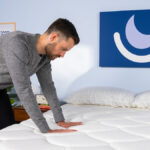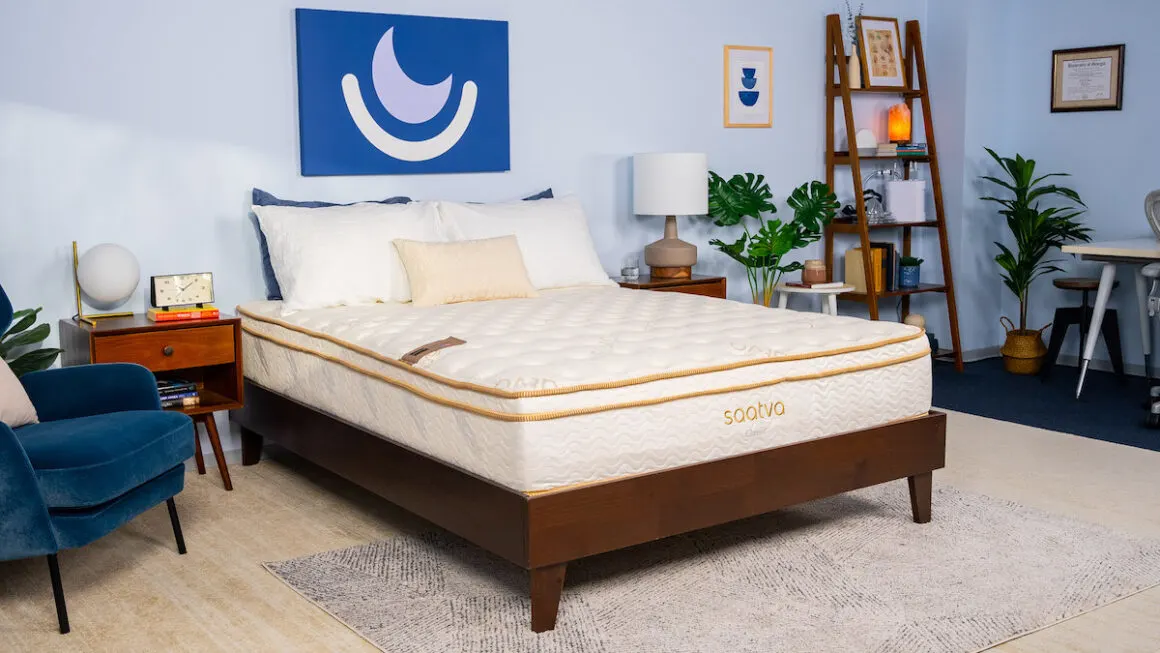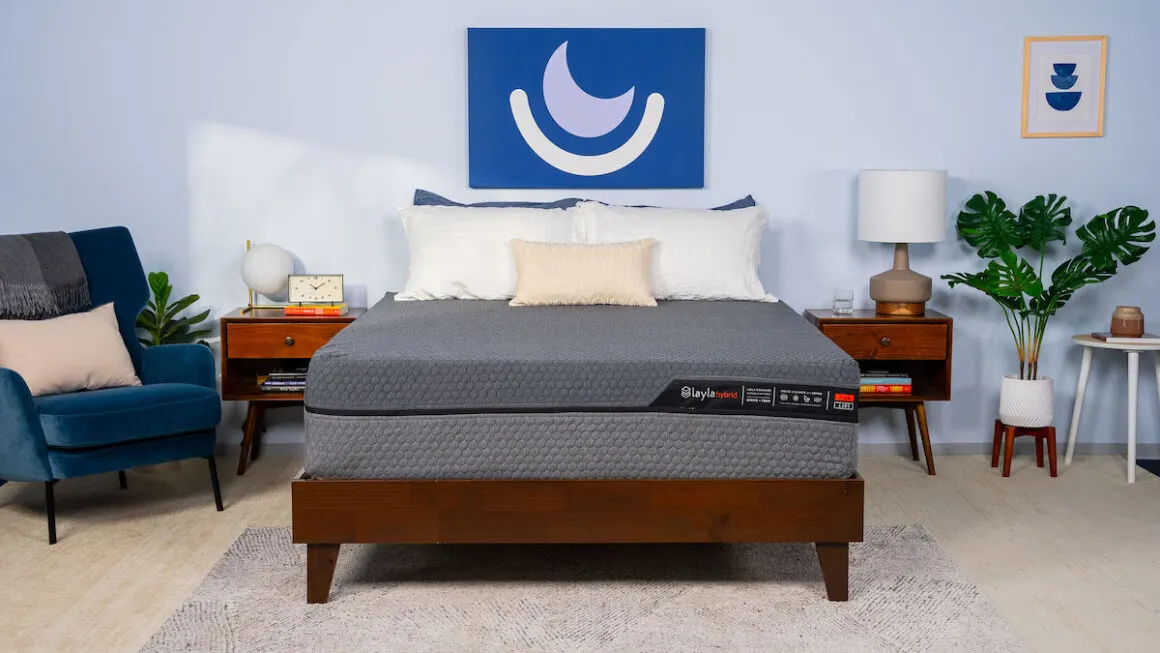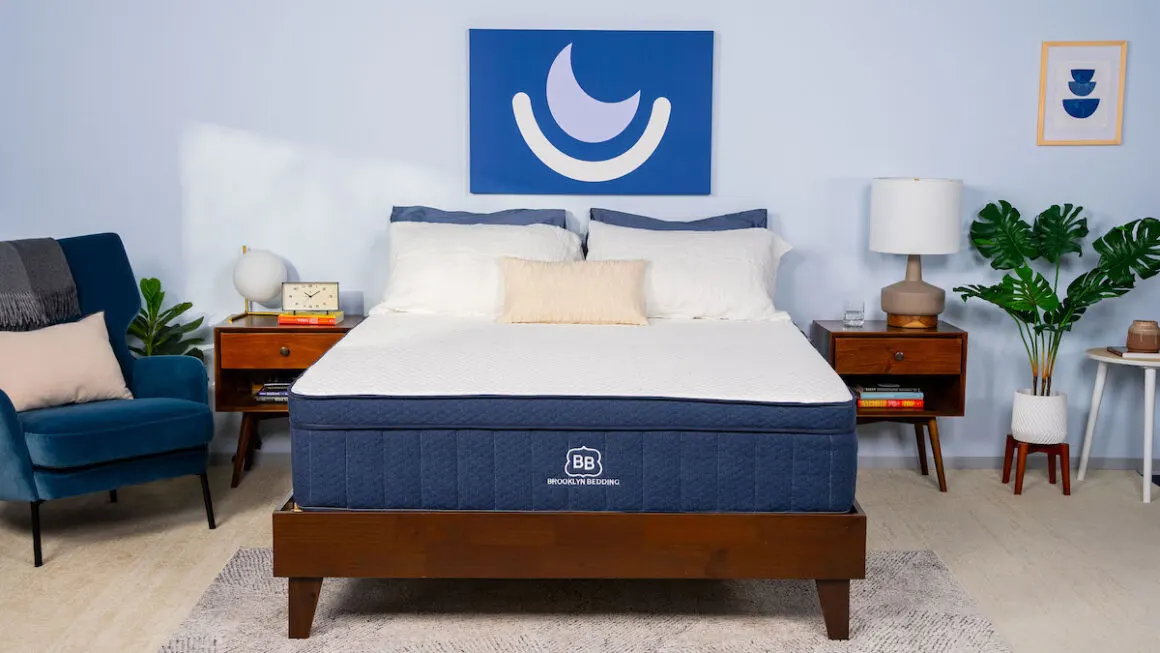And the Award for Best Mattress for Side and Stomach Sleepers Goes to…
The Saatva Classic’s unique dual-coil design and reinforced lumbar region strike a delicate balance of contouring and support. The mattress cradles a side sleeper’s hips and shoulders while providing an even plane to support a stomach sleeper’s spinal alignment.
If you sleep on both your side and your stomach, you know how hard it is to choose the right mattress. That’s because these two sleep positions typically require models on the opposite ends of the firmness and contouring spectrums.
While side sleepers generally need a softer surface with more contouring to prevent pressure buildup, stomach sleepers usually require firmer options with more support to promote spinal alignment. It can be difficult to find a model that offers the best of both worlds, but we’re here to help.
We’ll share our picks for the best mattress for side and stomach sleepers based on our extensive in-house testing and also explain some key considerations to keep in mind.
Alternatively, if you favor one position over the other, check out our guides to the best mattress for side sleepers and the best mattress for stomach sleepers.
The Best Mattresses for Side and Stomach Sleepers
Best Overall Mattress – Saatva Classic
Best Value Mattress – Nectar Mattress
Best Luxury Mattress – Leesa Legend
Best Mattress for Couples – Layla Hybrid
Best Cooling Mattress – Brooklyn Bedding Aurora
Read on to see why the following five options made our top picks list of 2024’s best mattresses for side and stomach sleepers.
Sleep Doctor’s Picks
Best Overall Mattress
Saatva Classic
The Sleep Doctor’s Review
The Saatva Classic’s distinct dual-coil design provides enough cradling for side sleeping and support for stomach sleeping. Additionally, the responsive surface facilitates position changes. Since you can select between soft (3), medium firm (6), and firm (8), there’s an option to accommodate virtually all body types.
Buy From SaatvaPros
- Reinforced lumbar region promotes good posture for side and stomach sleeping
- Responsive dual-coil design combines contouring and support
- Three firmness levels and two profile options
Cons
- Selecting the right firmness is essential to getting sufficient contouring and support
- The bounce of the coils may contribute to motion transfer
- As a luxury innerspring model, the Saatva Original’s price-point is higher than average
The Saatva Classic is an innerspring model available in 11.5- and 14.5-inch profiles. You can also select between three firmness options: soft (3), medium firm (6), and firm (8). This model’s unique design incorporates two coil layers, providing responsive contouring for our testers who sleep on their sides and even support for team members who sleep on their stomachs.
Why We Like It
The Saatva Classic is uniquely versatile. Because it comes in two profile options and three firmness levels, you can select a mattress more closely aligned to your personal needs and preferences.
A polyfoam Euro-top adds cushioning to soften the surface, while a memory foam lumbar pad promotes good posture across sleep positions. A layer of individually pocketed microcoils allows heavier body parts, like the hips, to sink in more deeply. Meanwhile, an innerspring coil core with polyfoam rails adds consistent support across the full surface of the mattress.
How Does It Feel?
Our testers noted that the Saatva Classic was simultaneously supportive, conforming, and highly responsive. When laying on their sides, the 3-inch Euro-top provided ample cushioning, and the pocketed microcoils gently cradled their hips and shoulders to ease pressure. Laying on their stomachs, our testers noticed that the extra support from the lumbar pad helped prevent their midsections from sinking too deeply.
In our tests, most team members under 230 pounds preferred the medium firm (6) for side and stomach sleeping. However, those over 230 pounds benefited from the extra support of the firm (8).
Best Value Mattress
Nectar Mattress
The Sleep Doctor’s Review
Despite the Nectar Mattress’ budget-friendly price-point, the affordable model accommodates most sleep positions and body types. Close-conforming memory foam helps redistribute pressure away from a side sleeper’s hips and shoulders, while a supportive polyfoam transition layer limits midsection sinkage that could strain a stomach sleeper’s back.
Buy From NectarPros
- Gel-infused memory foam for notable pressure relief
- Exceptional motion isolation
- Well suited for most body types and sleep positions
Cons
- Stomach sleepers over 230 pounds may benefit from more midsection support
- The hug of memory foam may impede position changes
- Couples often prefer a more responsive surface for sex
The Nectar Mattress is the flagship model from Nectar, a well-known online mattress company. This medium firm (6), all-foam mattress measures 12 inches thick. It incorporates a 2-inch comfort layer of memory foam to mold to a side sleeper’s curves without letting most stomach sleepers sink in excessively. Underneath, supportive polyfoam layers help promote spinal alignment.
Why We Like It
The Nectar Mattress is cost-effective without skimping on quality. It incorporates gel-infused memory foam designed for cooling and contouring followed by two layers of supportive polyfoam.
How Does It Feel?
We found the Nectar Mattress both conforming and supportive. The 2-inch memory foam comfort layer was deep enough to cradle our side sleepers’ hips and shoulders, but it also didn’t leave too much room for our stomach sleepers’ midsections to sink in before reaching the more supportive polyfoam transition layer.
While all of our testers thought that the Nectar was comfortable for side sleeping, those over 230 pounds felt their midsections sink in a bit too deeply when lying on their stomachs. That said, the mattress earned strong marks from stomach sleepers under 230 pounds.
Best Luxury Mattress
Leesa Legend
The Sleep Doctor’s Review
The Leesa Legend’s advanced design incorporates memory foam, polyfoam, and two coil systems for responsive contouring with limited sagging for a soft but supportive feel. A layer of zoned support also promotes good posture for both side and stomach sleepers while limiting pressure buildup.
Buy From LeesaPros
- Two pocketed coil systems for contouring, support, and breathability
- Zoned firmness for targeted support and pressure relief
- Balanced performance across the categories that typically matter most to sleepers
Cons
- Stomach sleepers over 230 pounds may notice some midsection sinkage
- Higher-than-average price-point may deter budget shoppers
- May have a slight initial odor
The Leesa Legend is a luxury hybrid model with a medium firm (6) feel and a 12-inch profile. Polyfoam, memory foam, and pocketed coils deeply cradle a side sleeper’s shoulders and hips, while zoning helps support a stomach sleeper’s midsection. This sophisticated design gives the bed a relatively plush feel despite its supportive construction, effectively accommodating both side and stomach sleepers.
Why We Like It
As a luxury hybrid model, the Leesa Legend uses an advanced design specifically crafted to excel across performance categories.
A top layer of ventilated polyfoam cushions the surface while letting heat escape. The following memory foam layer adds a pressure-relieving hug. Next, a zoned layer incorporates pocketed microcoils at the head and foot of the bed and polyfoam in the middle to promote good posture while easing pressure around a side sleeper’s shoulders. A coil core with a reinforced perimeter provides stable support and bounce, and a final layer of polyfoam acts as a base.
How Does It Feel?
Our team members reported that the Leesa Legend felt soft, supportive, and responsive. They enjoyed exceptional pressure relief when lying on their sides and could easily roll over onto their stomachs thanks to the two springy coil systems.Team members of all weights found the Leesa Legend comfortable for side sleeping since it limited pressure buildup around their hips and shoulders while supporting their spines.
Stomach sleepers under 230 pounds also got the midsection support they needed due to zoning in the pocketed microcoil layer. However, those over 230 pounds would have preferred a sturdier feel around the middle of the bed.
Best Mattress for Couples
Layla Hybrid
The Sleep Doctor’s Review
With two built-in firmness options, the Layla Hybrid is well suited to most side and stomach sleepers, including those with changing needs and preferences. Zoned support helps support a sleeper’s spine regardless of their sleep position, while memory foam relieves pressure points and reduces motion transfer.
Buy From LaylaPros
- Flippable mattress with a medium soft (4) and a firm (7) side
- Zoned support to promote good posture
- Balance of motion isolation and bounce thanks to the use of memory foam and pocketed coils
Cons
- The firm (7) side may lack sufficient contouring for side sleepers under 130 pounds
- The medium soft (4) side may not provide enough support to side sleepers over 230 pounds as well as back and stomach sleepers over 130 pounds
The Layla Hybrid is a 13-inch flippable hybrid with a different firmness on either side of the mattress. While the medium soft (4) side offers a plusher feel and deeper cradling, the firm (7) side provides enhanced support. Zoning enhances spinal support across sleep positions, and a coil core adds the bounce and edge support most couples look for in a mattress.
Why We Like It
The Layla Hybrid uses an uncommon two-sided design with a different firmness for either sleep surface. Both sides incorporate memory foam for contouring and zoned polyfoam for targeted support and airflow. Copper gel infusions in the memory foam layers are designed to wick away heat. Sandwiched between the two comfort systems, a pocketed coil core with a reinforced perimeter adds support, breathability, and bounce.
How Does It Feel?
In our tests, the Layla Hybrid’s performance varied depending on the firmness.
With the medium soft (4) side up, our testers under 130 pounds found the mattress comfortable across sleeping positions. Side sleepers between 130 and 230 pounds could also lie comfortably on the mattress. The memory foam comfort layer molded closely to these testers’ bodies, limiting pressure buildup. The medium soft side also excelled in motion isolation, so partners might not notice each others’ movements during the night.
For most couples, we’d recommend the firm (7) side, which worked for nearly all of our team members across weight groups and position preferences. Because the firm side of the Layla Hybrid accommodates most individuals, it might be a good compromise for partners with different preferences. In addition, we found the firm side cooler and easier to move on, which may be beneficial for sex.
Finally, we noticed stable edge support on both sides of the mattress, so most couples are likely to feel secure using the full mattress surface.
Best Cooling Mattress
Brooklyn Bedding Aurora Luxe
The Sleep Doctor’s Review
With three firmness options to choose from, most sleepers can find a version of the Brooklyn Bedding Aurora Luxe that works well for their body type, accommodating both side and stomach sleeping. Zoned support helps sleepers maintain better posture, while features designed for cooling combat heat retention.
Buy From Brooklyn BeddingPros
- Available in medium soft (4), medium firm (6), and firm (7)
- Advanced materials engineered for cooling
- Pressure-relieving memory foam and polyfoam comfort system
Cons
- Each firmness level accommodates some sleep positions and body types better than others
- Selecting the ideal firmness for you could be tricky
- Optional pillow-top costs extra
The Brooklyn Bedding Aurora Luxe is a 13.5-inch hybrid model that comes in three firmness options: medium soft (4), medium firm (6), and firm (7). In addition to providing zoned support and strong pressure relief appropriate for both side and stomach sleeping, the Aurora Luxe incorporates several technologies engineered for cooling to help sleepers maintain a more neutral temperature.
Why We Like It
Each firmness option varies slightly in its construction to achieve a unique balance of contouring and support for certain sleepers. All three contain a 1.5-inch top layer of polyfoam infused with copper and phase change material designed to dissipate body heat.
Next, the medium soft (4) and the medium firm (6) use a 2-inch polyfoam layer, while the firm (7) uses 1.5 inches. This material responds quickly to changes in pressure to facilitate position changes. The medium soft and the medium firm also include a 1-inch layer of gel-infused memory foam engineered to transfer heat away while molding to the shape of the sleeper’s body. Meanwhile, the firm uses 1.5 inches of polyfoam for sturdier support.
The mattress core consists of 8 inches of pocketed coils, allowing cooling air circulation while giving the bed a springier feel. With three firmness zones, the coil system adds enhanced support for the torso and hips to promote spinal alignment while fortifying the edge.
How Does It Feel?
While our testers noted that the different firmness options varied in their benefits and drawbacks, all three performed well in our temperature readings. Very little heat lingered on the surface of the medium firm (6) and firm (7). We detected a bit more residual body warmth on the medium soft (4), though our team members didn’t feel that it would be enough to interrupt their sleep.
Our pressure mapping also showed that each of the three firmness options distributed weight fairly evenly across the surface, preventing uncomfortable pressure buildup around the hips and shoulders of most of our testers who sleep on their sides.
What Kind of Support do Side and Stomach Sleepers Need From Their Mattress?
Both side and stomach sleepers need sufficient support to keep their spines aligned. They also frequently prefer a mattress with enough contouring to relieve pressure and prevent the surface from feeling hard.
The challenge is that these two sleep positions traditionally require very different levels of support and contouring. Because the hips and shoulders of most individuals are wider than the rest of their bodies, these areas tend to put more force on the mattress when side sleeping. Therefore, side sleepers generally need less support and more contouring, which usually means a softer mattress. In contrast, stomach sleepers typically need a firmer surface with more support to prevent their midsections from sagging and straining their lower backs.
With the right combination of support and contouring, side and stomach sleepers can maintain a healthy spinal alignment while preventing painful pressure points.
Features to Look for in a Mattress for Side and Stomach Sleepers
Side and stomach sleepers often look for the same features as everyone else, but these positions also introduce unique considerations to keep in mind. We’ll break down what you should look for.
Mattress Type
While every model is unique and performance may vary, each mattress type often shares common characteristics. Understanding these differences can make it easier to determine what’s best for you. Any of the common mattress varieties may be suitable for both side and stomach sleeping depending on your needs and the mattress’ firmness and construction.
- Foam: Foam models usually use a memory foam or polyfoam comfort system with a polyfoam core. Because of foam’s reputation for contouring, all-foam models are frequently touted as best for side sleeping. However, models designed to provide even support can also accommodate stomach sleepers.
- Hybrid: Hybrid models combine a foam or latex comfort system with a coil core. This fusion of cradling and support is often well suited to both side and stomach sleeping.
- Innerspring: Innerspring models traditionally consist primarily of springs, though modern options often incorporate pillow-tops for cushioning. Many innerspring beds provide sturdy support to help prevent a stomach sleeper’s midsection from sagging, while models with some cushioning can also ease pressure from a side sleeper’s hips and shoulders.
- Latex: Latex mattresses generally use natural latex in all layers of the bed, though more affordable synthetic and blended alternatives are available. Latex spreads compression over a wider area than memory foam or polyfoam, which effectively relieves pressure for side sleepers while limiting how deeply a stomach sleeper’s torso can sink in.
- Airbed: Airbeds typically consist of a memory foam or polyfoam comfort system over supportive air chambers. Sleepers can often empty or fill these air chambers using a remote or an app, allowing them to change the firmness throughout the night. For side and stomach sleepers concerned with always finding the ideal firmness, this can be a convenient solution.
Consider an Adjustable Bed
An adjustable bed allows you to change the position of the head of the bed and often the legs, providing a more versatile sleep experience.
The best adjustable bed for side and stomach sleeping should offer an incline feature that allows you to elevate the head end of the bed without bending the mattress, essentially putting the bed at an angle while maintaining a flat plane. This provides more options without forcing the body into an unnatural position that could jeopardize spinal alignment.
More conventional adjustable beds often bend the mattress, which carries its own implications. Side sleepers may still enjoy both pressure relief and more nuanced position options. At the same time, elevating either the head or foot of the bed is likely to create lower back strain for stomach sleepers, potentially encouraging them to switch to their sides or backs. Since doctors often advise against stomach sleeping, using an adjustable bed can be an easy way to break the habit.
Mattress Firmness
While the ideal mattress depends largely on your weight, many side and stomach sleepers prefer something on the higher end of the average firmness range. For sleepers between 130 and 230 pounds, medium firm (6) models often split the difference between a side sleeper’s preference for contouring and a stomach sleeper’s need for support. However, individuals who weigh less than 130 pounds may favor a slightly softer model to achieve the optimal balance, whereas those over 230 pounds might need a slightly firmer option.
Cushioning
Cushioning refers to how much give a mattress has. This directly impacts how soft or hard the surface feels. Contouring is a related concept used to discuss how a mattress forms to the shape of the sleeper’s body. Mattresses with ample cushioning and contouring typically reduce the accumulation of pressure by spreading the sleeper’s weight more evenly across the surface. These characteristics are usually particularly valuable for sleepers with aches and pains.
Most side sleepers look for notable cushioning and contouring since they’re prone to pressure buildup around their hips and shoulders. In contrast, stomach sleepers generally need just enough cushioning to prevent the mattress from feeling hard against the front of their bodies. Individuals who alternate between side and stomach sleeping often favor moderate cushioning and contouring to accommodate both positions.
Edge Support
Edge support describes how sturdy the perimeter of the mattress feels. Side sleepers often sleep close to the side of the bed, and good edge support can help them feel more secure. A stable perimeter also increases the usable mattress space by reducing the sensation that you may roll off the bed if you get too close to the edge. This can simplify position changes and give stomach sleepers who share their bed with a partner more room to spread out.
Sleepers with mobility issues also frequently prioritize edge support since it allows them to sit along the perimeter of the mattress to get into and out of bed.
Responsiveness
A responsive sleep surface returns to its original shape quickly when the sleeper moves, giving the bed a bouncy feel. For sleepers who alternate between side and stomach sleeping, a responsive mattress can simplify position changes. While this trait is convenient for virtually any sleeper who tends to change positions during the night, it may be especially important for those with mobility issues.
Temperature Regulation
Individuals who tend to sleep hot usually prefer a mattress with strong temperature regulation. Mattresses that excel in this area generally have breathable designs that allow cooling air circulation so that the sleeper’s body heat can dissipate naturally. Many also include technology designed to actively cool by transferring away the sleeper’s warmth.
Since the full front of a stomach sleeper’s body is in contact with the mattress, they may be particularly susceptible to overheating on a mattress without adequate temperature regulation.
Tips for Keeping Your Spine Aligned as a Side and Stomach Sleeper
Regardless of your sleep position, maintaining proper spinal alignment can enhance your comfort and reduce the risk of waking up with aches and pains. Side and stomach sleepers might make several changes to promote better posture.
- Invest in a Mattress Topper: If you’re not ready for a new mattress, a mattress topper might be right for you. Generally, toppers are used to make the surface softer, but you can also find options to make the bed slightly firmer. Incorporating a mattress topper can be an easy and affordable way to fine-tune the feel of your mattress to better accommodate both side and stomach sleeping.
- Add Extra Support With Pillows: Strategically placing extra pillows can improve posture for side and stomach sleepers. When sleeping on your side, you might place a pillow between your knees to keep your spine in a more neutral position. A body pillow can also help support a side sleeper’s upper leg while discouraging stomach sleeping. For stomach sleeping, a pillow under the hips could reduce lower back strain.
- Sleep With the Right Pillow Height: Using a pillow of the correct height for your sleep position helps maintain the natural curvature of your upper neck and spine. Unfortunately, the best pillow for side sleepers and the best pillow for stomach sleepers don’t have a lot in common. Side sleepers usually look for more supportive pillows with higher lofts, whereas stomach sleepers favor thin models to reduce neck strain. An adjustable pillow or a moldable mid-loft model might accommodate both positions.
Discover More Mattress Solutions
Check out our other detailed guides to find a mattress to suit your unique needs.
How We Test
Our team of experienced product testers have analyzed thousands of mattress models in our Seattle-based Test Lab to gather insights into their performance.
Our team members vary in body types and preferred sleep positions to give us a broad look at how each model might feel to different sleepers. In addition, we collect objective readings on key criteria, such as temperature control and pressure relief. This unique approach combines real sleeper feedback with data-backed analysis for a well-rounded overview of how each model performs for side and stomach sleepers.
Frequently Asked Questions
The best mattress for side and stomach sleepers balances contouring and support. Side sleepers benefit from the pressure relief that contouring provides, but too deep of cradling could jeopardize a stomach sleeper’s spinal alignment.
A mid-range mattress firmness is appropriate for most side and stomach sleepers. Medium firm (6) models often perform well for those between 130 and 230 pounds. Meanwhile, lighter individuals might prefer something slightly softer, and heavier individuals may favor something a bit firmer.
The best mattress for side sleepers with hip or shoulder pain typically molds to the sleeper’s curves without sagging under their weight. A close-conforming comfort system can help relieve pressure from their hips and shoulders, while sufficient support helps them maintain good sleep posture.
The best mattress for stomach sleepers with back pain is traditionally firm and highly supportive. Stomach sleepers often experience lower back pain as a result of their midsections sagging into the mattress and pulling their spines out of alignment. A firm, supportive model limits sinkage that could otherwise interfere with spinal alignment.
The best pillow loft is usually medium to high for side sleepers, low for stomach sleepers, and medium or adjustable for those who switch between the two positions.
Ask the Sleep Doctor
Have questions about sleep? Submit them here! We use your questions to help us decide topics for articles, videos, and newsletters. We try to answer as many questions as possible. You can also send us an email. Please note, we cannot provide specific medical advice, and always recommend you contact your doctor for any medical matters.






